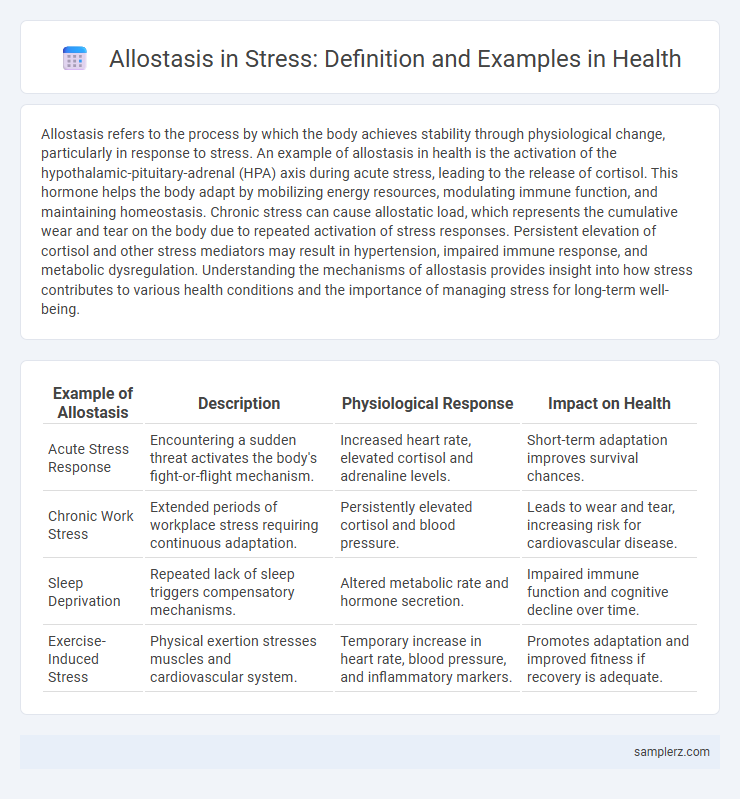Allostasis refers to the process by which the body achieves stability through physiological change, particularly in response to stress. An example of allostasis in health is the activation of the hypothalamic-pituitary-adrenal (HPA) axis during acute stress, leading to the release of cortisol. This hormone helps the body adapt by mobilizing energy resources, modulating immune function, and maintaining homeostasis. Chronic stress can cause allostatic load, which represents the cumulative wear and tear on the body due to repeated activation of stress responses. Persistent elevation of cortisol and other stress mediators may result in hypertension, impaired immune response, and metabolic dysregulation. Understanding the mechanisms of allostasis provides insight into how stress contributes to various health conditions and the importance of managing stress for long-term well-being.
Table of Comparison
| Example of Allostasis | Description | Physiological Response | Impact on Health |
|---|---|---|---|
| Acute Stress Response | Encountering a sudden threat activates the body's fight-or-flight mechanism. | Increased heart rate, elevated cortisol and adrenaline levels. | Short-term adaptation improves survival chances. |
| Chronic Work Stress | Extended periods of workplace stress requiring continuous adaptation. | Persistently elevated cortisol and blood pressure. | Leads to wear and tear, increasing risk for cardiovascular disease. |
| Sleep Deprivation | Repeated lack of sleep triggers compensatory mechanisms. | Altered metabolic rate and hormone secretion. | Impaired immune function and cognitive decline over time. |
| Exercise-Induced Stress | Physical exertion stresses muscles and cardiovascular system. | Temporary increase in heart rate, blood pressure, and inflammatory markers. | Promotes adaptation and improved fitness if recovery is adequate. |
Understanding Allostasis: The Body’s Adaptation to Stress
Allostasis refers to the body's dynamic process of achieving stability through physiological or behavioral change in response to stressors. For example, during a stressful situation, the hypothalamic-pituitary-adrenal (HPA) axis activates, releasing cortisol to increase energy availability and modulate immune function. This adaptive response helps maintain homeostasis but prolonged activation can lead to wear and tear, known as allostatic load.
Acute Stress Response: Allostasis in Action
The acute stress response exemplifies allostasis by rapidly activating the hypothalamic-pituitary-adrenal (HPA) axis and sympathetic nervous system to restore homeostasis. This mechanism triggers the release of cortisol and adrenaline, mobilizing energy and enhancing cardiovascular function to meet immediate threats. Efficient allostatic responses prevent long-term damage by adapting physiological processes during acute stress episodes.
Chronic Stress: When Allostatic Load Increases
Chronic stress leads to an increased allostatic load, where the body's adaptive systems, such as the hypothalamic-pituitary-adrenal (HPA) axis and autonomic nervous system, remain overactivated for prolonged periods. This persistent activation results in wear and tear on physiological systems, contributing to hypertension, insulin resistance, and immune suppression. Elevated allostatic load serves as a key biomarker for assessing health risks associated with long-term stress exposure.
The Role of Hormones in Allostatic Regulation
Hormones such as cortisol and adrenaline play a crucial role in allostatic regulation by modulating the body's response to stress, enabling adaptation to changing environmental demands. Chronic activation of these hormones, however, can lead to allostatic load, resulting in detrimental health effects such as hypertension, immune suppression, and metabolic imbalances. Precise hormonal regulation ensures optimal physiological function, maintaining homeostasis while facilitating dynamic stress responses.
Allostasis in Mental Health: Coping with Emotional Stress
Allostasis in mental health involves adaptive physiological and psychological responses to emotional stress, such as the release of cortisol to manage anxiety and enhance focus during challenging situations. Chronic activation of allostatic systems can lead to allostatic load, increasing vulnerability to depression, anxiety disorders, and cognitive impairment. Effective coping strategies, including mindfulness and cognitive-behavioral therapy, help regulate allostatic responses to maintain emotional resilience and mental well-being.
Exercise and Allostatic Adaptation to Physical Stress
Exercise induces allostatic adaptation by triggering physiological responses that enhance the body's ability to manage physical stress. Through regular physical activity, systems such as the cardiovascular, endocrine, and immune systems adjust to maintain homeostasis despite increased demands. This allostatic process results in improved stress resilience, reduced inflammation, and optimized metabolic function, contributing to long-term health benefits.
Sleep Patterns and Allostasis During Stressful Periods
Stress triggers allostasis by altering sleep patterns, disrupting circadian rhythms, and increasing cortisol levels, which impacts restorative sleep cycles. Chronic stress-induced allostatic load impairs immune function and cognitive performance due to reduced deep sleep and frequent awakenings. Maintaining consistent sleep hygiene during stressful periods supports the body's adaptive allostatic processes and promotes overall health resilience.
Immune System Modulation: Allostasis Under Stress
Chronic stress triggers allostasis by dynamically modulating the immune system, leading to altered cytokine production and inflammation levels. Glucocorticoids released during stress suppress immune responses, balancing between protection and potential immune dysfunction. This adaptive immune modulation exemplifies allostatic processes aimed at maintaining homeostasis despite persistent stressors.
Social Support as an Allostatic Buffer for Stress
Social support functions as a powerful allostatic buffer by enhancing the body's ability to regulate stress responses and reduce the cumulative physiological wear from chronic stress exposure. Studies show that individuals with strong social networks exhibit lower cortisol levels and improved cardiovascular health under stress, highlighting social support's role in maintaining homeostasis. Effective social support mechanisms activate neural pathways that modulate the hypothalamic-pituitary-adrenal (HPA) axis, thereby mitigating the negative impact of allostatic load on mental and physical health.
Long-Term Health Consequences of Allostatic Overload
Allostatic overload, resulting from chronic stress, triggers prolonged activation of the hypothalamic-pituitary-adrenal (HPA) axis, leading to excessive cortisol production that impairs immune function and increases inflammation. This dysregulation contributes to long-term health consequences such as hypertension, cardiovascular disease, metabolic syndrome, and cognitive decline. Persistent allostatic overload disrupts homeostasis, accelerating wear and tear on bodily systems and escalating the risk of chronic illnesses.

example of allostasis in stress Infographic
 samplerz.com
samplerz.com